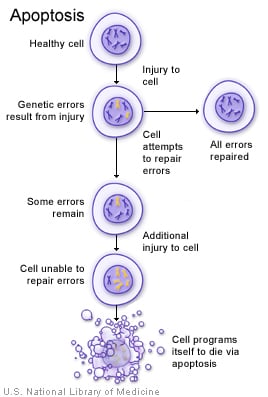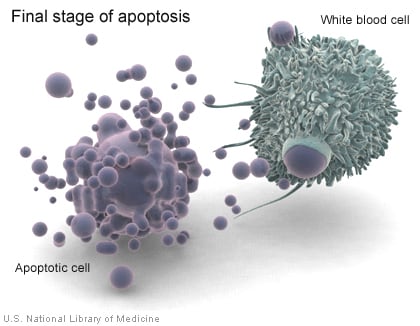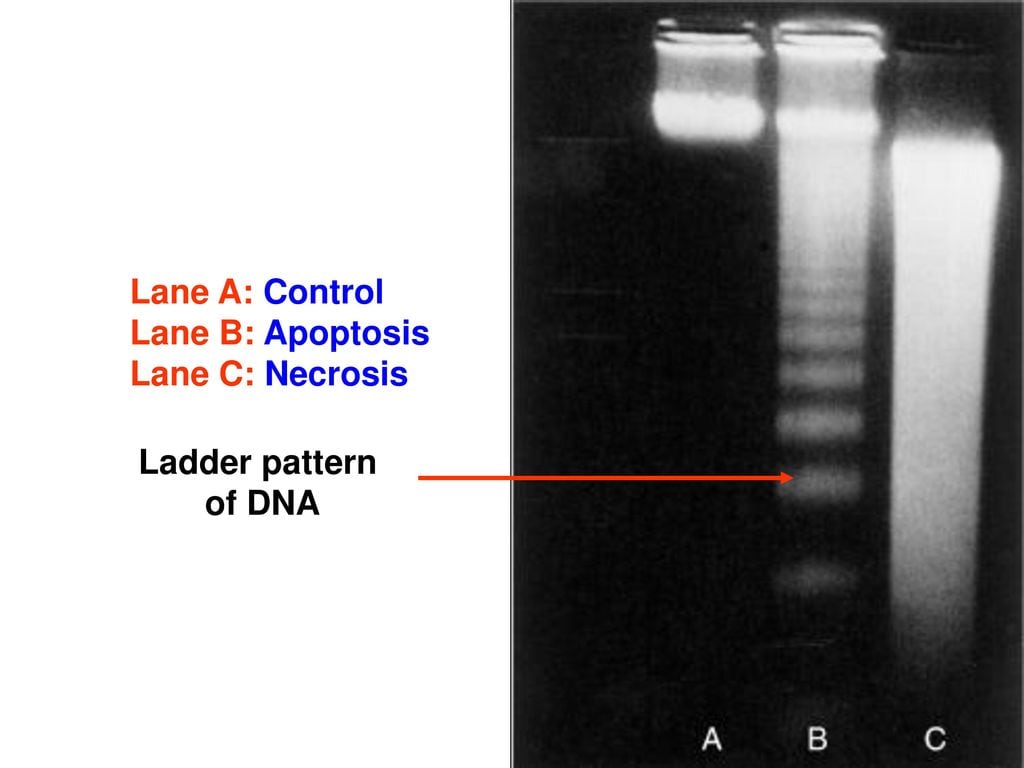Apoptosis is programmed cell death. It can occur from physiological or pathological causes.

Apoptosis is initiated by two different pathways - extrinsic or death receptor pathway and the intrinsic or mitochondrial pathway. Both pathways lead to the activation of caspases that cause cell death. Caspases are cysteine containing proteases.

Extrinsic or death receptor initiated pathway: This pathway is initiated by ligand binding to the death receptor. Death receptors are members of the tumor necrosis factor family and are present on the cell surface e.g. Fas or CD95 and type 1 TNF receptor. They have intracellular domains that indirectly activate caspases. Binding of FasL or Fas ligand to Fas is followed by cross linking and results in the activation of the cytoplasmic domain called FADD or Fas associated death domain. FADD in turn binds to pro-caspases which are activated to caspases. This pathway of activation can be inhibited by a protein called FLIP and is used by some viruses to inhibit Fas mediated apoptosis.
Intrinsic or mitochondrial pathway: This pathway is a result of increased mitochondrial permeability which results in the release of pro-apoptotic factors that induce the caspases. It involves both pro and anti-apoptotic members of the Bcl-2 family. Bcl-2 and Bcl-x are anti-apoptotic molecules that normally reside in the mitochondrial membrane. When the intrinsic pathway is initiated, Bcl-2 and Bcl-x are lost from the mitochondrial membrane and are replaced by pro-apoptotic molecules Bak, Bax and Bim. This causes increased mitochondrial permeability and escape of cyt c from the mitochondria into the cytosol. Cyt c binds to Apaf -1 or apoptosis activating factor -1 which activates caspases, leading to apoptosis. Normally, Bcl-2 and Bcl-x inhibit Apaf -1 activation. AIF or apoptosis inducing factor enter the cytoplasm and inactivate inhibitors of apoptosis.

Apoptotic cells shrink, cytoplasm becomes dense, chromatin condenses and aggregates peripherally under the nuclear membrane, cell surface blebs and buds are formed, followed by fragmentation of the cell into apoptotic bodies. They look deeply eosinophilic on H and E stained sections. There is a characteristic absence of inflammation. Apoptotic cells show a characteristic breakdown of DNA into large 50 to 300 kilobase pieces which is further cleaved into segments of 180-200 base pairs. These fragments can be visualized on agarose gel electrophoresis as a DNA ladder. Typically this type of DNA ladder is not seen in necrotic cells. Apoptotic cells have markers which can be recognized by macrophages.

Examples: Apoptosis can be initiated due to lack of growth factors or hormones, by DNA damage, cytotoxic T cells or tumor necrosis factor or TNF receptors. It can be physiological in embryogenesis , menstruation and apoptosis of immune cells at the end of an immune response. Pathological apoptosis can result from infections like viral hepatitis and from DNA damage from radiation or chemotherapy etc. Apoptosis due to growth factor , hormone or cytokine deficiency is by the intrinsic pathway. DNA damage causes arrest of the cell cycle in G1 phase by p53. When the damage cannot be repaired, p53 induces apoptosis. FasL or CD95L is the ligand for Fas or CD95. It is produced by immune cells and initiates the extrinsic pathway of apoptosis. It is involved in apoptosis of self -reactive T cells. TNF binds to TNFR1 or TNF receptor 1. This causes TRADD or TNF receptor associated death domain protein to associate with the intracellular domain and then bind to FADD, inducing the extrinsic pathway.
Cytotoxic T lymphocytes (CTLs) have a unique method of inducing apoptosis by direct activation of caspases by granzymes secreted by the CTLs.
Sign up for free to take 5 quiz questions on this topic